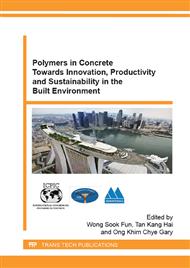[1]
F. Glasser, J. Marchand, E. Samson, Durability of concrete, Degradation phenomena involving detrimental chemical reactions, Cem. Concr. Res. 38 (2008) 226-246.
DOI: 10.1016/j.cemconres.2007.09.015
Google Scholar
[2]
F. Pacheco-Torgal, J.P. Castro-Gomes, S. Jalali, Alkali – activated binders: a review Part 1 Historical background, terminology, reaction mechanisms and hydration products, Constr. Build. Mat. 22 (2008) 1305-1314.
DOI: 10.1016/j.conbuildmat.2007.10.015
Google Scholar
[3]
F. Pacheco-Torgal, Z. Abdollahnejad, S. Miraldo, S. Baklouti, Y. Ding, An overview on the potential of geopolymers for concrete infrastructure rehabilitation, Constr. Build. Mat. 36 (2012) 1053-1058.
DOI: 10.1016/j.conbuildmat.2012.07.003
Google Scholar
[4]
A. Almusallam, F. Khan, S. Dulaijan, O. Al-Amoudi Effectiveness of surface coatings in improving concrete durability, Cem. Concr. Comp. 25 (2003) 473–481.
DOI: 10.1016/s0958-9465(02)00087-2
Google Scholar
[5]
J. Aguiar, P. Moreira, P. Lukowski, L. Czarnecki, A. Camões, D. Van Gemert Ranking procedure for polymeric coatings and hydrophobic agents for concrete protection, Restoration of Buildings and Monuments 13 (2007) 251-264.
DOI: 10.1515/rbm-2007-6143
Google Scholar
[6]
J.B. Aguiar, A. Camões, P.M. Moreira, Coatings for concrete protection against aggressive environments, J. Adv. Concr. Tech. 6 (2008) 243-250.
DOI: 10.3151/jact.6.243
Google Scholar
[7]
M. Berndt, Evaluation of coatings, mortars and mix design for protection of concrete against sulphur oxidising bacteria, Constr. Build. Mat. 25 (2011) 3893–3902.
DOI: 10.1016/j.conbuildmat.2011.04.014
Google Scholar
[8]
M. Medeiros, P. Helene, Efficacy of surface hydrophobic agents in reducing water and chloride ion penetration in concrete, Mater. Struct. 41 (2008) 59-71.
DOI: 10.1617/s11527-006-9218-5
Google Scholar
[9]
F. Pacheco-Torgal, S. Jalali, Sulphuric acid resistance of plain, polymer modified, and fly ash cement concretes. Constr. Build. Mater. 23 (2009) 3485–3491.
DOI: 10.1016/j.conbuildmat.2009.08.001
Google Scholar
[10]
A. Brenna, F. Bolzoni, S. Beretta, M. Ormellese, Long-term chloride-induced corrosion monitoring of reinforced concrete coated with commercial polymer-modified mortar and polymeric coatings, Constr. Build. Mat. 48 (2013) 734–744.
DOI: 10.1016/j.conbuildmat.2013.07.099
Google Scholar
[11]
J. Bijen, Durability of engineering structures, Design, repair and maintenance, Woodhead Publishing Limited, Abington Hall, Cambridge (2000).
Google Scholar
[12]
F. Pacheco-Torgal, S. Jalali, Toxicity of building materials, A key issue in sustainable construction. International Journal of Sustainable Engineering, Taylor & Francis 4, (2011) 281-287.
DOI: 10.1080/19397038.2011.569583
Google Scholar
[13]
F. Pacheco-Torgal, S. Jalali, A. Fucic, Toxicity of Building Materials, Woodhead Publishing Limited, Cambridge (2012).
DOI: 10.1533/9780857096357
Google Scholar
[14]
F. Pacheco-Torgal, J.P. Castro-Gomes, S. Jalali, Adhesion characterization of tungsten mine waste geopolymeric binder. Influence of OPC concrete substrate surface treatment, Constr. Build. Mater. 22 (2008) 154-161.
DOI: 10.1016/j.conbuildmat.2006.10.005
Google Scholar
[15]
F. Pacheco-Torgal, J.A. Labrincha, C. Leonelli, A. Palomo, P. Chindaprasirt, Handbook of Alkali-Activated Cements, Mortars and Concretes ed., 1. Abington Hall, Cambridge, UK: WoodHead Publishing Limited- Elsevier Science and Technology (2014).
DOI: 10.1533/9781782422884.1
Google Scholar
[16]
J. Provis, J.S.J. Van Deventer, Geopolymers: Structure, Processing, Properties and Industrial Applications, Woodhead Publishing, Cambridge, UK (2009).
Google Scholar
[17]
J. Provis, Geopolymers and other alkali activated materials: why, how, and what ? J. Mat. Struct. 47 (2014) 11-25.
DOI: 10.1617/s11527-013-0211-5
Google Scholar
[18]
J.S.J. Van Deventer, J. Provis, P. Duxson, Technical and commercial progress in the adoption of geopolymer cement", Min. Eng. 29, (2012) 89-104.
DOI: 10.1016/j.mineng.2011.09.009
Google Scholar
[19]
F. Pacheco-Torgal, J.P. Castro-Gomes, S. Jalali, Investigations on mix design of tungsten mine waste geopolymeric binders, Constr. Build. Mat. 22 (2008) 1939-(1949).
DOI: 10.1016/j.conbuildmat.2007.07.015
Google Scholar
[20]
W.K. Lee, J.S.J. Van Deventer, The effect of ionic contaminants on the early-age properties of alcali-activated fly ash-based cements, Cem. Concr. Res. 32 (2002) 577-584.
DOI: 10.1016/s0008-8846(01)00724-4
Google Scholar
[21]
R. Ferreira, Evaluation of durability test, Master Thesis, University of Minho, Guimaraes, Portugal (2000).
Google Scholar
[22]
ERMCO – European ready-mixed concrete industry statistics – 2013 (2014).
Google Scholar
[23]
F. Pacheco-Torgal, J.P. Castro-Gomes, Influence of physical and geometrical properties of granite and limestone aggregates on the durability of a C20/25 strength class concrete, Const. Build. Mat. 20 (2006) 1079-1088.
DOI: 10.1016/j.conbuildmat.2005.01.063
Google Scholar
[24]
A. Allahverdi, F. Škvára, Nitric acid attack on hardened paste of geopolymeric cements, Part 1, Ceram –Silik, 45 (2001) 81-88.
Google Scholar
[25]
A. Allahverdi, F. Škvára, Nitric acid attack on hardened paste of geopolymeric cements, Part 2, Ceram –Silik, 45 (2001) 143-149.
Google Scholar
[26]
A. Fernandez-Jimenez, I. Garcıa-Lodeiro, A. Palomo, Durability of alkali-activated fly ash cementitious materials, J. Mater. Sci. 42 (2007) 3055–3065.
DOI: 10.1007/s10853-006-0584-8
Google Scholar


